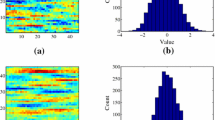Abstract
This paper describes a novel approach for creating an efficient, general, and differentiable parameterization of large-scale non-Gaussian, non-stationary random fields (represented by multipoint geostatistics) that is capable of reproducing complex geological structures such as channels. Such parameterizations are appropriate for use with gradient-based algorithms applied to, for example, history-matching or uncertainty propagation. It is known that the standard Karhunen–Loeve (K–L) expansion, also called linear principal component analysis or PCA, can be used as a differentiable parameterization of input random fields defining the geological model. The standard K–L model is, however, limited in two respects. It requires an eigen-decomposition of the covariance matrix of the random field, which is prohibitively expensive for large models. In addition, it preserves only the two-point statistics of a random field, which is insufficient for reproducing complex structures.
In this work, kernel PCA is applied to address the limitations associated with the standard K–L expansion. Although widely used in machine learning applications, it does not appear to have found any application for geological model parameterization. With kernel PCA, an eigen-decomposition of a small matrix called the kernel matrix is performed instead of the full covariance matrix. The method is much more efficient than the standard K–L procedure. Through use of higher order polynomial kernels, which implicitly define a high-dimensionality feature space, kernel PCA further enables the preservation of high-order statistics of the random field, instead of just two-point statistics as in the K–L method. The kernel PCA eigen-decomposition proceeds using a set of realizations created by geostatistical simulation (honoring two-point or multipoint statistics) rather than the analytical covariance function. We demonstrate that kernel PCA is capable of generating differentiable parameterizations that reproduce the essential features of complex geological structures represented by multipoint geostatistics. The kernel PCA representation is then applied to history match a water flooding problem. This example demonstrates that kernel PCA can be used with gradient-based history matching to provide models that match production history while maintaining multipoint geostatistics consistent with the underlying training image.
Similar content being viewed by others
References
Caers J, Hoffman T (2006) The probability perturbation method: a new look at Bayesian inverse modeling. Math Geol 38:81–100
Caers J, Zhang T (2004) Multiple-point geostatistics: a quantitative vehicle for integrating geologic analogs into multiple reservoir models. AAPG Mem 80:383–394
Deutsch C, Journel A (1998) GSLIB: geostatistical software library and user’s guide, 2nd edn. Oxford University Press, New York, 384 p
Franc V, Hlavac V (2004) Statistical pattern recognition toolbox for matlab: user’s guide. Czech Technical University, Prague, 97 p
Gavalas GR, Shah PC, Seinfeld JH (1976) Reservoir history matching by Bayesian estimation. SPE J 16:337–350
Golub GH, van Loan CF (1996) Matrix computations. The John Hopkins Press, Baltimore, 664 p
Hu LY, Blanc G, Noetinger B (2001) Gradual deformation and iterative calibration of sequential stochastic simulations. Math Geol 33:475–489
Huang SP, Quek ST, Phoon KK (2001) Convergence study of the truncated Karhunen–Loeve expansion for simulation of stochastic processes. Int J Numer Methods Eng 52:1029–1043
Jansen JD, Brouwer DR, Naevdal G, van Kruijsdiik CPJW (2005) Closed-loop reservoir management. First Break 23:43–48
Kirby M, Sirovich L (1990) Application of the Karhunen–Loeve procedure for the characterization of human faces. IEEE Trans Pattern Anal Mach Intell 12(1):103–108
Kitanidis PK (1986) Parameter uncertainty in estimation of spatial functions: Bayesian estimation. Water Resour 22(4):499–507
Kwok JT, Tsang IW (2004) The pre-image problem with Kernel methods. IEEE Trans Neural Netw 15:1517–1525
Oliver DS (1996) Multiple realizations of the permeability field from well test data. SPE J 1:145–154
Oliver DS, He N, Reynolds AC (1996) Conditioning permeability fields to pressure data. Presented at the 5th European conference on the mathematics of oil recovery, Leoben, Austria
Reynolds AC, He N, Chu L, Oliver DS (1996) Reparameterization techniques for generating reservoir descriptions conditioned to variograms and well-test pressure data. SPE J 1:413–426
Sakamoto S, Ghanem R (2002) Polynomial chaos decomposition for the simulation of non-Gaussian nonstationary stochastic processes. J Eng Mech 128:190–201
Sarma P (2006) Efficient closed-loop optimal control of petroleum reservoirs under uncertainty. PhD thesis, Stanford University, Stanford
Sarma P, Durlofsky LJ, Aziz K (2005) Efficient closed-loop production optimization under uncertainty. SPE paper 94241 presented at the SPE Europec/EAGE annual conference, Madrid, Spain
Sarma P, Durlofsky LJ, Aziz K (2006a) Computational techniques for closed-loop reservoir modeling with application to a realistic reservoir. Presented at the European conference on the mathematics of oil recovery X (ECMORX), Amsterdam, Netherlands
Sarma P, Durlofsky LJ, Aziz K, Chen WH (2006b) Efficient real-time reservoir management using adjoint-based optimal control and model updating. Comput Geosci 10:3–36
Sarma P, Durlofsky LJ, Aziz K, Chen WH (2007) A new approach to automatic history matching using kernel PCA. SPE paper 106176 presented at the reservoir simulation symposium, The Woodlands, TX
Scholkopf B, Smola AJ (2002) Learning with kernels. MIT Press, Cambridge, 664 p
Scholkopf B, Mika S, Smola AJ, Ratsch G, Muller KR (1998a) Kernel PCA pattern reconstruction via approximate pre-images. Presented at the 8th international conference on artificial neural networks, Skovde, Sweden
Scholkopf B, Smola AJ, Muller KR (1998b) Nonlinear component analysis as a kernel eigenvalue problem. Neur Comput 10:1299–1319
Sirovich L (1987) Turbulence and the dynamics of coherent structures, Parts i–iii. J Appl Math 45(3):561–90
Strebelle S (2002) Conditional simulation of complex geological structures using multiple-point statistics. Math Geol 34:1–21
Strebelle S, Journel A (2001) Reservoir modeling using multiple-point statistics. SPE paper 71324 presented at the SPE annual technical conference and exhibition, New Orleans, LA
Author information
Authors and Affiliations
Corresponding author
Rights and permissions
About this article
Cite this article
Sarma, P., Durlofsky, L.J. & Aziz, K. Kernel Principal Component Analysis for Efficient, Differentiable Parameterization of Multipoint Geostatistics. Math Geosci 40, 3–32 (2008). https://doi.org/10.1007/s11004-007-9131-7
Received:
Accepted:
Published:
Issue Date:
DOI: https://doi.org/10.1007/s11004-007-9131-7




